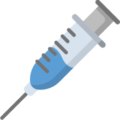Author(s)
Brittany Schmidt, PharmD, BCACP
Don Branam, PharmD, BCPS
Reviewed By
Michelle Balli, PharmD, BCACP
Sharya V. Bourdet, PharmD, BCPS
Butler CC, Gillespie D, White P, et al. C-reactive protein testing to guide antibiotic prescribing for COPD exacerbations. N Engl J Med. 2019; 381: 111-20.
The Problem
Patients frequently present to outpatient clinics and community pharmacies with acute exacerbations of chronic obstructive pulmonary disease (AECOPD) and clinicians have an important decision to make. Should they prescribe (or NOT prescribe) antibiotics? Patients may seek antibiotics as a quick fix to their symptoms, but many AECOPD are not caused by bacterial infection.1 The decision to prescribe antibiotics is based on the patient’s presenting symptoms and risk for complications from an AECOPD.1 Prescribing unnecessary antibiotics exposes patients to adverse effects and can increase antimicrobial resistance. But not prescribing antibiotics could delay recovery if the exacerbation is of bacterial origin … or worse, result in an avoidable hospitalization and death.
What’s Known
COPD affects nearly 16 million Americans and was the 3rd leading cause of death in 2014.2 AECOPD are frequently treated with bronchodilators, corticosteroids, and antibiotics.1 Three clinical criteria are often used as indicators of when to prescribe antibiotics for patients with AECOPD: 1) increased dyspnea, 2) increased sputum volume, and 3) increased sputum purulence.3 Currently, the Global Initiative for Chronic Obstructive Lung Disease (GOLD) guidelines recommend antibiotic therapy for patients when increased sputum purulence is present and at least 2 of these criteria are met.1 The GOLD guidelines acknowledge that most AECOPD are not caused by bacterial infections but instead may be provoked by viruses, allergens, or other environmental factors.1 Clinicians may feel pressure to prescribe antibiotics out of caution rather than necessity as delay in improvement from AECOPD can lead to worse outcomes for patients.4
Measuring C-reactive protein (CRP), an acute phase reactant associated with inflammation, may be a helpful biomarker in patients with AECOPD. Point-of-care CRP testing was previously shown to predict response to antibiotics in patients with AECOPD but a large, pragmatic study is needed before the use of CRP in the setting of AECOPD can be widely adopted.5
What’s New
The results of the PACE study, an open-label, randomized controlled trial conducted in 86 primary care clinics in the United Kingdom, provides compelling evidence about the potential use of CRP to guide the decision to prescribe antibiotics in patients with AECOPD.6 Patients were included in the study if they were age 40 or older with a COPD diagnosis and had one or more of the clinical criteria consistent with an AECOPD. Patients with severe symptoms and those requiring hospitalization were excluded. Patients were randomly assigned to either a usual care group or CRP-guided group. Regardless of the assigned group, clinicians were asked to base their decision on whether to prescribe an antibiotic on the patient’s symptoms and health status and to weigh the benefits and risks. In the CRP-guided group, clinicians were asked to obtain a point-of-care CRP test to aid in the decision making.6 Clinicians were provided guidance on how to interpret the results as shown in table 1.
Table 1. Guidance on Interpreting Point-of-Care CRP Results6
|
CRP Result |
Recommended Interpretation |
|
< 20 mg/L |
Antibiotic therapy is unlikely to be beneficial. |
|
20-40 mg/L |
Antibiotic therapy may be beneficial. |
|
> 40 mg/L |
Antibiotic therapy is likely to be beneficial. |
The co-primary outcomes of the study included 1) patient-reported use of antibiotics within 4 weeks of randomization, and 2) COPD-related health status measured using the Clinical COPD Questionnaire 2 weeks after randomization. Higher scores on Clinical COPD Questionnaire indicate worsening health status. All patients had telephonic follow-up and in-person interviews to assess if they used antibiotics. Changes in COPD-related health status were assessed for non-inferiority between the groups. Primary outcomes were assessed using a full and modified intention-to-treat analyses.6
Six-hundred fifty-three patients were randomized. Baseline characteristics were well balanced between groups and notable patient characteristics are shown in table 2. Severity of COPD, assessed by GOLD staging, was known for 180 patients in the usual care group and 172 in the CRP-guided group. Of those, 81.7% in the usual care group and 84.3% in the CRP-guided group had stage II or III COPD.6
Table 2. Notable Baseline Patient Characteristics6
|
|
Usual Care Group |
CRP-guided group |
|
Mean age, years |
68.3 |
67.8 |
|
Male |
173 (53.4%) |
162 (49.8%) |
|
Mean # of symptomatic days before presenting to clinic |
7.1 |
6.8 |
|
Mean score on the Clinical COPD Questionnaire |
3.3 |
3.2 |
|
Number of clinical criteria present at the time of study enrollment |
||
|
1 |
81 (25.0%) |
76 (23.4%) |
|
2 |
98 (30.2%) |
100 (30.8%) |
|
3 |
145 (44.8%) |
149 (45.8%) |
Three-hundred seventeen patients assigned to the CRP-guided group had a point-of-care CRP test completed. Of those, 241 (76%) had a level less than 20 mg/L; 38 (12%) had a level between 20 and 40 mg/L; and the remaining 38 (12%) had a level higher than 40 mg/L.6
Significantly fewer patients in the CRP-guided group self-reported receiving antibiotics compared to the usual care group [150 of 263 (57.0%) vs. 212 of 274 (77.4%); OR = 0.31; 95% CI 0.20 to 0.47]. Moreover, the results from the Clinical COPD Questionnaire favored patients in the CRP-guided group (-0.19 mean point difference; two-sided 90% CI -0.33 to -0.05.) Interestingly, patients in the CRP-guided group who met at least 2 out of 3 criteria were significantly less likely to receive antibiotics.6 This finding raises the intriguing possibility that the current GOLD guideline recommendation to use antibiotics should be reconsidered. The study authors concluded that point-of-care CRP testing for patients presenting to a primary care clinic for an AECOPD reduces the rate of antibiotic prescribing without worsening patient symptoms.6
Our Critical Appraisal
One of the key strengths of this study is its real-world approach. While utilizing point-of-care CRP testing as part of the decision in the CRP-guided group, clinicians still had autonomy to prescribe antibiotics based on individual patient characteristics. Additionally, the primary outcome, while patient self-reported and subject to recall bias, accounted for patient behavior and other potential sources for antibiotics including care provided by non-study providers and the use of previously prescribed antibiotics. By collecting self-reported antibiotic use, any antibiotic use was captured. While the manufacturer of the point-of-care test provided the testing device and training, they did not have any role in the study design or reporting.6
There were some notable limitations to the study. The trial was based in the United Kingdom so the findings may not be generalizable to other healthcare delivery systems or patient populations. Additionally, patients with severe AECOPD requiring hospitalization were excluded, so the results should not be applied to patients who require inpatient care. Another potential problem is the unblinded nature of the study — both clinicians and patients were aware of their group assignment. Patients might have been more or less likely to report antibiotic use and knowledge of their group assignment may have influenced how they responded to questions on the Clinical COPD Questionnaire. Another limitation is that the point-of-care testing device used in this study is not currently available in the United States.7
Most patients (76%) in the CRP-guided group had a CRP level less than 20 mg/L suggesting antibiotics may not be necessary or beneficial in the majority of cases. Nonetheless, 57% of the patients in the CRP-guided group self-reported antibiotic use.6 The study did not differentiate between patient self-reported antibiotic use and CRP level.
The Bottom Line
Using point-of-care tests was advocated in the U.S. National Action Plan for Combating Antibiotic-Resistant Bacteria.8 Point-of-care CRP testing may aid in the decision to prescribe antibiotics for mild or moderate AECOPD. However, patients’ symptoms and health status are still important factors to consider. Surveys of primary care clinicians suggest that cost and lack of reimbursement are barriers to the implementation of point-of-care tests in practice.9 Despite the potential to help decrease antibiotic prescribing, point-of-care CRP testing is not routinely available in primary care offices in the United States. We believe CRP testing should be more widely available and routinely used to make better-informed decisions about antibiotic prescribing in patients with AECOPD.
The Key Points
- Point-of-care CRP testing may decrease antibiotic prescribing for AECOPD without negatively impacting patient symptoms.
- Point-of care CRP testing is not a substitute for collecting a good patient history.
- Tools, such as point-of-care testing devices, are only effective if they are readily available and clinicians use them.
FINAL NOTE: This program will be available for recertification credit through the American Pharmacists Association (APhA) Ambulatory Care Review and Recertification Program. To learn more, visit https://www.pharmacist.com/ambulatory-care-review-and-recertification-activities.
- Global Initiative for Chronic Obstructive Lung Disease (GOLD). Global strategy for the diagnosis, management, and prevention of chronic obstructive pulmonary disease, 2019. http://www.goldcopd.org.
- National Center for Chronic Disease Prevention and Health Promotion, Division of Population Health. Basics about COPD. Centers for Disease Control and Prevention website. https://www.cdc.gov/copd/basics-about.html. July 19, 2019. Accessed August 25, 2019.
- Anthonisen NR, Manfreda J, Warren CP, et al. Antibiotic therapy in exacerbations of chronic obstructive pulmonary disease. Ann Intern Med. 1987;106: 196-204.
- Donaldson GC, Law M, Kowlessar B, et al. Impact of prolonged exacerbation recovery in chronic obstructive pulmonary disease. Am J Respir Crit Care Med. 2015; 192(8): 943-50.
- Miravitlles M, Moragas A, Hernández S, et al. Is it possible to identify exacerbations of mild to moderate COPD that do not require antibiotic treatment? Chest. 2013; 144(5): 1571-7.
- Butler CC, Gillespie D, White P, et al. C-reactive protein testing to guide antibiotic prescribing for COPD exacerbations. N Engl J Med 2019; 381: 111-20.
- C-reactive protein. Abbott website. https://www.testtargettreat.com/en/home/rapid-diagnostics/c-reactive-protein.html. Accessed August 25, 2019.
- Office of the Press Secretary, The White House. Task Force for Combating Antibiotic-Resistant Bacteria. National action plan for combating antibiotic-resistant bacteria. Washington, DC: U.S. Government Printing Office; 2015. Available from: https://obamawhitehouse.archives.gov/sites/default/files/docs/national_action_plan_for_combating_antibotic-resistant_bacteria.pdf. Accessed August 27, 2019.
- Sohn AJ, Hickner JM, Alem F. Use of point-of-care tests (POCTs) by US primary care physicians. J Am Board Fam Med. 2016; 29: 371-6.



 iForumRx.org is a web-based community of practice designed to inform ambulatory care pharmacy specialists, pharmacy residents, and student pharmacists about high-quality, practice-changing evidence.
iForumRx.org is a web-based community of practice designed to inform ambulatory care pharmacy specialists, pharmacy residents, and student pharmacists about high-quality, practice-changing evidence.